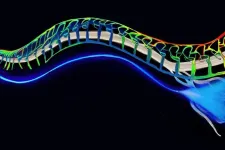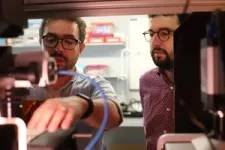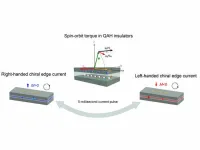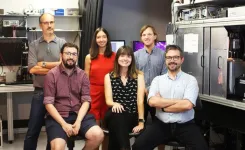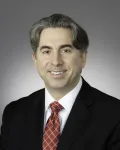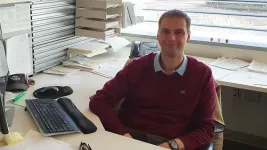(Press-News.org) Scientists have a new tool to precisely illuminate the roots of nerve pain.
Engineers at MIT have developed soft and implantable fibers that can deliver light to major nerves through the body. When these nerves are genetically manipulated to respond to light, the fibers can send pulses of light to the nerves to inhibit pain. The optical fibers are flexible and stretch with the body.
The new fibers are meant as an experimental tool that can be used by scientists to explore the causes and potential treatments for peripheral nerve disorders in animal models. Peripheral nerve pain can occur when nerves outside the brain and spinal cord are damaged, resulting in tingling, numbness, and pain in affected limbs. Peripheral neuropathy is estimated to affect more than 20 million people in the United States.
“Current devices used to study nerve disorders are made of stiff materials that constrain movement, so that we can’t really study spinal cord injury and recovery if pain is involved,” says Siyuan Rao, assistant professor of biomedical engineering at the University of Massachusetts at Amherst, who carried out part of the work as a postdoc at MIT. “Our fibers can adapt to natural motion and do their work while not limiting the motion of the subject. That can give us more precise information.”
“Now, people have a tool to study the diseases related to the peripheral nervous system, in very dynamic, natural, and unconstrained conditions,” adds Xinyue Liu PhD ’22, who is now an assistant professor at Michigan State University (MSU).
Details of their team’s new fibers will be reported in a study appearing in Nature Methods. Rao’s and Liu’s MIT co-authors include Atharva Sahasrabudhe, a graduate student in chemistry; Xuanhe Zhao, professor of mechanical engineering and civil and environmental engineering; and Polina Anikeeva, professor of materials science and engineering, along with others at MSU, UMass-Amherst, Harvard Medical School, and the National Institutes of Health.
Beyond the brain
The new study grew out of the team’s desire to expand the use of optogenetics beyond the brain. Optogenetics is a technique by which nerves are genetically engineered to respond to light. Exposure to that light can then either activate or inhibit the nerve, which can give scientists information about how the nerve works and interacts with its surroundings.
Neuroscientists have applied optogenetics in animals to precisely trace the neural pathways underlying a range of brain disorders, including addiction, Parkinson’s disease, and mood and sleep disorders — information that has led to targeted therapies for these conditions.
To date, optogenetics has been primarily employed in the brain, an area that lacks pain receptors, which allows for the relatively painless implantation of rigid devices. However, the rigid devices can still damage neural tissues. The MIT team wondered whether the technique could be expanded to nerves outside the brain. Just as with the brain and spinal cord, nerves in the peripheral system can experience a range of impairment, including sciatica, motor neuron disease, and general numbness and pain.
Optogenetics could help neuroscientists identify specific causes of peripheral nerve conditions as well as test therapies to alleviate them. But the main hurdle to implementing the technique beyond the brain is motion. Peripheral nerves experience constant pushing and pulling from the surrounding muscles and tissues. If rigid silicon devices were used in the periphery, they would constrain an animal’s natural movement and potentially cause tissue damage.
Crystals and light
The researchers looked to develop an alternative that could work and move with the body. Their new design is a soft, stretchable, transparent fiber made from hydrogel — a rubbery, biocompatible mix of polymers and water, the ratio of which they tuned to create tiny, nanoscale crystals of polymers scattered throughout a more Jell-O-like solution.
The fiber embodies two layers — a core and an outer shell or “cladding.” The team mixed the solutions of each layer to generate a specific crystal arrangement. This arrangement gave each layer a specific, different refractive index, and together the layers kept any light traveling through the fiber from escaping or scattering away.
The team tested the optical fibers in mice whose nerves were genetically modified to respond to blue light that would excite neural activity or yellow light that would inhibit their activity. They found that even with the implanted fiber in place, mice were able to run freely on a wheel. After two months of wheel exercises, amounting to some 30,000 cycles, the researchers found the fiber was still robust and resistant to fatigue, and could also transmit light efficiently to trigger muscle contraction.
The team then turned on a yellow laser and ran it through the implanted fiber. Using standard laboratory procedures for assessing pain inhibition, they observed that the mice were much less sensitive to pain than rodents that were not stimulated with light. The fibers were able to significantly inhibit sciatic pain in those light-stimulated mice.
The researchers see the fibers as a new tool that can help scientists identify the roots of pain and other peripheral nerve disorders.
“We are focusing on the fiber as a new neuroscience technology,” Liu says. “We hope to help dissect mechanisms underlying pain in the peripheral nervous system. With time, our technology may help identify novel mechanistic therapies for chronic pain and other debilitating conditions such as nerve degeneration or injury.”
This research was supported, in part, by the National Institutes of Health, the National Science Foundation, the U.S. Army Research Office, the McGovern Institute for Brain Research, the Hock E. Tan and K. Lisa Yang Center for Autism Research, the K. Lisa Yang Brain-Body Center, and the Brain and Behavior Research Foundation.
###
Written by Jennifer Chu, MIT News Office
END
Soft optical fibers block pain while moving and stretching with the body
The fibers could help with testing treatments for nerve-related pain.
2023-10-19
ELSE PRESS RELEASES FROM THIS DATE:
Electrical control of quantum phenomenon could improve future electronic devices
2023-10-19
UNIVERSITY PARK, Pa. — A new electrical method to conveniently change the direction of electron flow in some quantum materials could have implications for the development of next-generation electronic devices and quantum computers. A team of researchers from Penn State developed and demonstrated the method in materials that exhibit the quantum anomalous Hall (QAH) effect — a phenomenon in which the flow of electrons along the edge of a material does not lose energy. The team described the work in a paper appearing today (Oct. 19) in the journal Nature ...
A change in rigidity switches the function of protein condensates involved in sensing touch
2023-10-19
Touch plays a fundamental role in our physical, emotional, and social well-being. From a primary way of conveying emotions to sensory integration, it is crucial for the complex growth of cognitive, emotional, social, and behavioral abilities especially during the early development of infants and children. Touch allows us to build connections with others, eases pain and stress, and helps us to understand the world around us giving crucial information such as the texture, temperature, and shape of objects.
When sensing any stimuli, such as when the body is being touched, the mechanical signals are transformed into biological responses ...
From square to cube: Hardware processing for AI goes 3D, boosting processing power
2023-10-19
A breakthrough development in photonic-electronic hardware could significantly boost processing power for AI and machine learning applications.
The approach uses multiple radio frequencies to encode data, enabling multiple calculations to be carried out in parallel.
The method shows promise for outperforming state-of-the-art electronic processors, with further enhancements possible.
In a paper published today in Nature Photonics, researchers from the University of Oxford, along with collaborators from the Universities of Muenster, Heidelberg, and Exeter, report on their development ...
Self-powered flexible multicolor electrochromic devices for information displays
2023-10-19
In recent years, self-powered electrochromic (EC) devices have shown significant potential in various fields such as optoelectronics, sensors, and security systems. These self-powered EC systems, capable of reversible color switching without external power sources, have garnered considerable interest for next-generation electronic devices. However, this field is still in its infancy, with several unresolved challenges, including monochromatic displays, limited cycle durability, and the use of aqueous electrolytes. All these limitations have become ...
Urgent action needed to address climate change threats to coastal areas
2023-10-19
Global coastal adaptations are ‘incremental in scale’, short-sighted and inadequate to address the root causes of vulnerability to climate change, according to an international team of researchers.
The 17 experts, including Prof Robert Nicholls, Professor of Climate Adaptation at the University of East Anglia (UEA), have contributed to the paper, ‘Status of global coastal adaptation’, which is published today in Nature Climate Change.
Prof Nicholls said: “Recent analyses conclude that despite adaptation undertaken in all regions and sectors, global action remains incremental in scale: policies and projects ...
Cancer drug that targets two immune-evading tumor tactics performs well in early clinical trial
2023-10-19
A “two-for-one” cancer immunotherapy is potentially more effective and at least as safe as standard immunotherapies, physician-scientists from UPMC Hillman Cancer Center who led an international, early-phase clinical trial report today in the journal Nature Medicine.
The findings, which involved hundreds of patients with different types of advanced solid tumors or blood cancers, point to an enticing new path for bispecific therapies that more efficiently unleash the patient’s own immune system to eliminate the cancer.
“No approved ...
International team develops novel DNA nano engine
2023-10-19
An international team of scientists has recently developed a novel type of nano engine made of DNA. It is driven by a clever mechanism and can perform pulsing movements. The researchers are now planning to fit it with a coupling and install it as a drive in complex nano machines. Their results were just published today in the journal Nature Nanotechnology.
Petr Šulc, an assistant professor at Arizona State University's School of Molecular Sciences and the Biodesign Center for Molecular Design and Biomimetics, has collaborated with professor ...
Killer smile? An oral pathogen increases heart attack damage
2023-10-19
Researchers from Tokyo Medical and Dental University(TMDU) find that a periodontal pathogen, Porphyromonas gingivalis, inhibits autophagosome–lysosome fusion, and can therefore worsen cardiac remodeling and cause cardiac rupture after myocardial infarction
Tokyo, Japan – Brushing and flossing regularly can keep your smile shining as brightly as ever, but did you know that it could also help protect your heart? Now, researchers in Japan report that an infected mouth could lead to a broken ...
Modulation of protein stability: a new approach to studying cosolvent effects
2023-10-19
Controlling the process of destabilization is important when manipulating the unfolding and refolding of proteins in vitro (outside their native environment). To this end, urea and alcohol are used as cosolvents, substances added in small amounts along with water, to destabilize and denature proteins. Urea disturbs a native protein to produce disordered coils, and the interference by alcohol treatment yields helical structures. Research on the mechanism of cosolvents has shown that a protein’s stability between its native and denatured states is tied ...
Hook-ups where one partner is drunker more likely to be seen as assault
2023-10-19
Hook-ups where one partner is drunker than the other are more likely to be seen as assault, researchers at the University of Essex revealed.
A study by Dr Veronica Lamarche, from the Department of Psychology, discovered equal consumption was more important than levels of drunkenness.
This was the case even when couples had drunk to excess and was the same across sexualities and genders.
Dr Lamarche discovered that romantic rendezvous were seen most positively when couples drank the same low level of alcohol.
And encounters where one partner was ...
LAST 30 PRESS RELEASES:
Autistic and non-autistic faces may “speak a different language” when expressing emotion
No clear evidence that cannabis-based medicines relieve chronic nerve pain
Pioneering second-order nonlinear vibrational nanoscopy for interfacial molecular systems beyond the diffraction limit
Bottleneck in hydrogen distribution jeopardises billions in clean energy
Lung cancer death rates among women in Europe are finally levelling off
Scientists trace microplastics in fertilizer from fields to the beach
The Lancet Obstetrics, Gynecology, & Women’s Health: Taking paracetamol during pregnancy does not increase risk of autism, ADHD or intellectual disabilities, confirms new gold-standard evidence review
Taking paracetamol during pregnancy does not increase risk of autism, ADHD or intellectual disabilities
Harm reduction vending machines in New York State expand access to overdose treatment and drug test strips, UB studies confirm
University of Phoenix releases white paper on Credit for Prior Learning as a catalyst for internal mobility and retention
Canada losing track of salmon health as climate and industrial threats mount
Molecular sieve-confined Pt-FeOx catalysts achieve highly efficient reversible hydrogen cycle of methylcyclohexane-toluene
Investment in farm productivity tools key to reducing greenhouse gas
New review highlights electrochemical pathways to recover uranium from wastewater and seawater
Hidden pollutants in shale gas development raise environmental concerns, new review finds
Discarded cigarette butts transformed into high performance energy storage materials
Researchers highlight role of alternative RNA splicing in schizophrenia
NTU Singapore scientists find new way to disarm antibiotic-resistant bacteria and restore healing in chronic wounds
Research suggests nationwide racial bias in media reporting on gun violence
Revealing the cell’s nanocourier at work
Health impacts of nursing home staffing
Public views about opioid overdose and people with opioid use disorder
Age-related changes in sperm DNA may play a role in autism risk
Ambitious model fails to explain near-death experiences, experts say
Multifaceted effects of inward foreign direct investment on new venture creation
Exploring mutations that spontaneously switch on a key brain cell receptor
Two-step genome editing enables the creation of full-length humanized mouse models
Pusan National University researchers develop light-activated tissue adhesive patch for rapid, watertight neurosurgical sealing
Study finds so-called super agers tend to have at least two key genetic advantages
Brain stimulation device cleared for ADHD in the US is overall safe but ineffective
[Press-News.org] Soft optical fibers block pain while moving and stretching with the bodyThe fibers could help with testing treatments for nerve-related pain.
